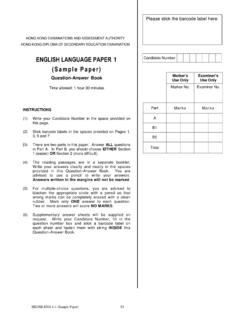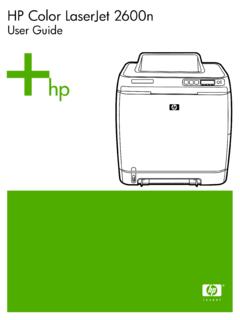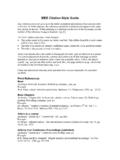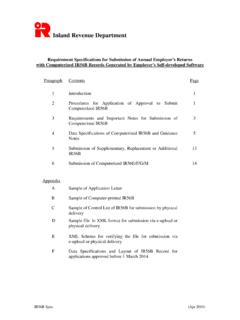Transcription of Dynaco ST-120 with VTA driver board Kit …
1 Dynaco ST-120 with VTA driver board Kit instruction manual Triode/ pentode version Congratulations on your purchase of the Dynaco ST-120 with VTA driver board kit. Every effort has been made to give you the finest sounding, most reliable and best looking 60 watt per channel kit presently available. ALL parts in this kit are NEW there are no recycled parts from older original Dynaco amplifiers. Your Dynaco kit features the following items which are all upgrades from the original Dynaco kits. 1. A new STAINLESS STEEL chassis that is identical in size, shape and markings to the older original nickel plated steel frame. This chassis is NON-MAGNETIC and removes any magnetic interference effects of a steel chassis on the audio circuitry. 2. Quality USA made A-260-120 custom wound output transformers which are interleaved/layer-wound and incorporate high quality M-6 grain oriented laminations. 3. A more robust PA-060-120 power transformer rated at 120 volts, having 420-0-420 secondaries and a 450 milliamp current transfer capability.
2 4. Quality Celanex tube sockets 5. All stainless steel screws with zinc plated kep nuts 6. An 80, 40, 30, 20 main electrolytic cap with a 525 volt continuous use rating. 7. An all triode VTA driver board made of mil-spec epoxy fiberglass. This board also contains an on board bias supply for the output tubes and eight premium Sprague 716P film and foil coupling caps. 8. Gold plated input and output terminals. 9. A dual choke system rated at 400 milliamps 10. Triode/ pentode switches to allow the amp to run in two modes of operation 11. A supplementary cap module with ESL reduction capacitors The KIT comes with a very easy to follow instruction manual and a clear pictorial specific to the VTA driver board . All you need is to complete the kit is a soldering pencil, some rosin core solder, a screwdriver, pliers and a wire cutter/stripper to build your own Dynaco ST-120 . The kit takes about 10-12 hours to build depending on your skill level and any previous experience with kit building. List of Parts 1 - Stainless Steel chassis frame with bottom cover 1 - VTA driver board with parts set 7 - 8 pin Celanex octal tube sockets 1 USA made PA-060-120 power transformer 4 - hard rubber isolation washers for power transformer 2 - A-260-120 USA made custom interleave/layer wound output transformers 2 - C-354 chokes 1 - multi section 525 volt rated (80, 40, 30, 20) quadruple capacitor 1 - three lug terminal strip 1 - one lug terminal strip 1 - pair of gold plated RCA input jack jacks with mounting board 2 - pair of gold plated output binding posts with mounting board 1 - rubber grommet 1 - fuse post with 5 amp SLO-BLO fuse 2 - SPST slide switches 1 - 13 amp rated AC power cord 2.
3 022 Mfd 600 volt capacitors 4 - 1000 ohm 1 watt resistors 4 - 10 ohm 2 watt bias resistors 1 - 6800 ohm 2 watt resistor for quad cap 1 Supplementary Cap Module (SCM) 1 Set of ESL reduction capacitors 1 - hardware kit for amp 1 - 22 foot coil of 20 gauge tinned solid core copper wire 1 triode/ pentode kit (2 DPDT switches, two 2 lug terminal strips, 4 X 100 ohm 1 watt resistors) OPTIONAL > One tube set 4 X 6550 or KT88, 3 X 12AT7, 1 X GZ34 rectifier Optionally painting the transformers Power and output transformers come from the factory with minor surface imperfections. You may, as an option, paint your transformers for a better appearance with some type of heat resistant paint. Recommended, are any type of paint used to paint automobile engine blocks (engine enamel) or paint used to paint barbecue grilles. To most people a semi-gloss paint looks best on transformers. Use a spray can don t brush it on. Recommended paints are Krylon BBQ and Stove paint (Krylon # 1618) OR any type of semi-gloss automobile engine enamel in a spray can.
4 This is carried by Wal-Mart and many other stores. Go to an auto supply store for engine enamel. 1. Obtain SIX 8 X 32 machine screws 2 to 3 inches long with nuts. 2. Remove one transformer 8 X 32 nut, nylon spacer(s) and screw and replace it with one of the six machine screws and nut. Tighten the nut securely. 3. Do the same for the transformer screw on the opposite diagonal corner of the transformer. 4. Remove the other two 8 X 32 screws, nylon spacers and nuts on that transformer. 5. Repeat steps 2 through 4 for the other two transformers. 6. Sand any imperfections in the factory paint off the three transformers with 100 grit paper. Sand again with 220 grit paper 7. Remove all sanding dust from the outer surface of the transformer. 8. Cover the transformer wires by placing them in a plastic bag. Use some masking tape near the transformer to hold the bag on the wires. 9. Spray 3 light coats on each transformer and allow to dry overnight. 10. Remove the plastic bags that cover the wires 11.
5 Reinstall all the original screws, spacers and nuts. ASSEMBLY instructions NOTE You may or may not want to construct the VTA driver board BEFORE or AFTER you attach the chassis parts. If you wish to construct the VTA driver board at this time skip ahead to the VTA driver board instructions which are inside the VTA package and proceed with its construction. When you are through come back to this point and begin mounting the chassis parts. Obtain the chassis. Remove the four stainless steel 6 X 32 screws. Taped inside the chassis are four one inch round rubber feet which you may stick on the outside of the chassis bottom cover over the four holes in the cover. Orient the chassis with the power transformer cutout facing you and mark V1 , V2 , V3 , V6 and V7 with a felt tip marker on the inside of the chassis next to the appropriate tube socket as marked on the pictorial. The symbol (S) means to solder that connection at that time. If you don t see the symbol do not solder that connection at that time.
6 1. Mount the FIVE octal sockets that fit on the chassis TOP from the BOTTOM OF THE CHASSIS with inch long 4-40 stainless steel screws and 4-40 kep nuts. Use the pictorial to orient the keyway of each tube properly. On V2, V3 and V6 mount a GROUND LUG around the outside screw closest to the side of the chassis and face the lug towards pin 8. On V7 mount TWO GROUND LUGS around the outside screw face one towards pin 8 and one towards pin 2. Tighten all nuts securely. DO NOT MOUNT the two front power take off tube sockets at this time. 2. Disassemble the two gold plated speaker binding posts from the mounting plates. Attach the LEFT and RIGHT mounting plates to the back INSIDE of the amp with 4-40 hardware. Reassemble the speaker binding posts on to the mounting plates. One of the black spacers with rounded edges goes INSIDE the chassis and the other black spacer goes OUTSIDE the chassis. Make sure that the BLACK terminal is on the side that says G on the outside of the chassis frame.
7 Tighten the two studs with the gold plated nuts provided. 3. Mount the rubber grommet in the 3/8 inch hole in the back CENTER of the chassis. 4. Mount the fuse holder in the "D shaped hole in the back of the chassis. Tighten the nut but do not over tighten as this may cause the plastic threads to break. Check and make sure that the 5 amp SLO-BLO fuse is inside the fuse holder. 5. Mount the SPST on/off switch on the REAR of the chassis with 4-40 hardware. Make sure that the two terminals on this switch are close to the UNDERSIDE OF THE CHASSIS TOP SURFACE. Check the pictorial. 6. Place the 4 rubber isolation washers on the ends of each of the four bolts of the PA-060-120 power transformer. Mount the power transformer in the large center cut out. The wires should face the FRONT of the chassis. Fasten the power transformer to the chassis with four 8-32 kep nuts. In the original amp a metal cable clamp was used on each of the two front bolts as seen on the pictorial. These clamps are not really necessary as the wires will stay in place fine when soldered.
8 7. Assemble the Supplementary Cap Module (SCM) A. Obtain the four lug terminal strip from the SCM kit plastic bag B. Hold the strip with the grounded lug that attaches to the chassis towards you - that grounded lug is lug 1 and the next three lugs are lugs 2, 3 and 4. C. Connect a 330K resistor between lugs 1 and 2 - have the resistor straight in line with the terminal strip and not on the side of the lug. D. Connect a jumper wire between lugs 2 and 3 - have the jumper straight in line with the terminal strip and not on the side of the lug. E. Connect a 330K resistor between lugs 3 and 4 - have the resistor straight in line with the terminal strip and not on the side of the lug. F. Connect a 4 inch wire to lug 4 and run the wire to the side opposite the ground lug attachment hole. G. Obtain one of the two supplementary caps and connect the NEGATIVE terminal of this cap (the terminal with the BLACK STRIPE next to it) to lug 1 of the terminal strip. Connect it on the side OPPOSITE the chassis attachment hole.
9 (S) Fit the other lug of this cap into lug 2 of the terminal strip (S) H. Fit the OTHER supplementary cap on the OTHER SIDE of the terminal strip with the NEGATIVE terminal (the terminal with the BLACK STRIPE next to it) in lug 3 (S) and the POSITIVE terminal in lug 4 (S) 8. Mount the first C-354 choke and the SCM on the RIGHT side of the chassis with two 8-32 screws and matching kep nuts. The SCM (not seen on the pictorial but seen in color photo) is attached under the left screw and nut. Make sure that the two choke leads and the wire from pin 4 of the SCM face towards the FRONT of the chassis. 9. Mount the THREE lug terminal strip on the LEFT side of the chassis with a single 4-40 screw and kep nut as shown on the pictorial. Use the screw hole closest to the power transformer. 10. Mount the RIGHT A-260-120 output transformer with 8-32 hardware. The side of the transformer with the YELLOW-ORANGE-BROWN-BLACK leads must face the BACK of the amp. Mount the LEFT output transformer and fit the SECOND C-354 choke under the far left nut closest to the FRONT of the chassis.
10 NOTE This choke mounts with just that ONE nut and screw. The two wires on the choke should face the INSIDE of the chassis. Check the pictorial and/or photo. 11. Mount the quadruple section filter capacitor in the special cutout. It is IMPORTANT that the quad cap be properly oriented. The 80 Mfd SECTION which is designated with a HALF CIRCLE symbol must face the BACK of the amp. Fasten by twisting each of the four mounting tabs one-quarter turn. 12. Mount the ONE LUG terminal strip in the hole just to the left of the quad cap. This will be your main grounding point for the entire amp. The original amp had two grounding tabs as is seen in the pictorial. 13. Please refer to the triode/ pentode pictorial for installing the triode/ pentode switches. Obtain the two non shorting DPDT switches from the triode/ pentode kit bag. Install the switches in the two chassis holes where the original Dynaco ST-70 bias controls use to be. These two 3/8 holes are not shown on the main pictorial. The switches are a loose fit in the holes and must be centered in the hole before they are tightened.







